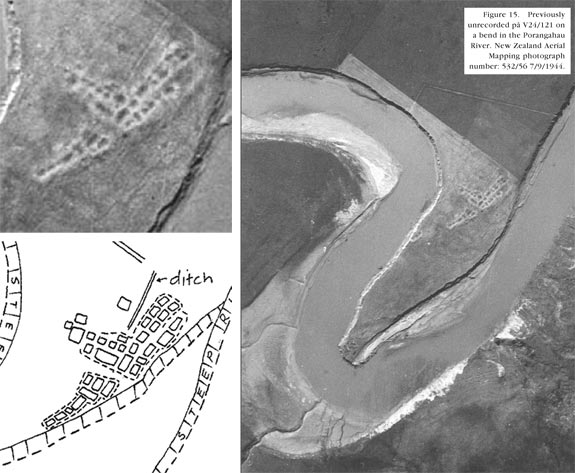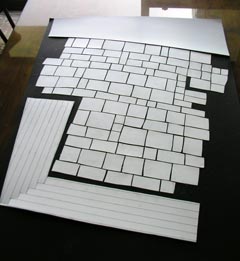Adaptation of archaeological form to paving patterns
By Philip Smith –O2 Landscapes
‘Form grammar’ is a term that may be used to refer to the organisation of, and relationship between, forms. The predominant type of ‘form grammar’ applied by designers in New Zealand is based on the formal geometric tradition laid down by the European forebears of our modern society (and further reinforced by the dominance of modernism within art and architecture over the last 50 years). In recent years, many artists and designers have also derived inspiration from the infinite variety of forms and processes of the natural world, to investigate different ways of thinking1.
This essay concerns inspiration from a source of forms which may be described as ‘hybrid’ in nature, combining aspects of both formal geometric design and naturalistic form –archaeological settlement patterns. It is explained within the context of the work that we carried out at a site on the foothills of Te Mata Peak, in which we adapted the patterns of pre-European Māori settlement sites from the southern Hawke’s Bay to derive our paving system.
 Jones & Tanner (2002).2 p. 25 (fig. 14 & 15).
Jones & Tanner (2002).2 p. 25 (fig. 14 & 15).
One of the most intriguing characteristics of many early settlement sites is that they represent a very direct response to the landscape. They have been sculpted in response to external factors, such as defensibility, drainage, water supply and topography. This stands in contrast to the removed manner in which we often build nowadays.
There is a pseudo-organic nature to their shapes, that is reminiscent of the work of the early 20th Century French-German artist, Hans Arp. They also bear resemblance to sections of the paving that the Greek architect, Dimitris Pikionis, arranged adjacent to the Acropolis in Athens, during the mid-1950s. As mentioned in the portfolio section of the website, Pikionis’ work inspired us to look into the idea that has been put into place on the site.
The way in which these polygonoid shapes relate to each other reflects the influence of topography upon their composition. One can see this in the diagram presented above, in which many of the forms are composed in a wave-like alignment. Within the same diagram, one can also see the alternating mix of regularity and irregularity present in the composition; an unusual ‘staccato’ rhythm which gives it a dynamic character.


The process of adapting the source material into a workable scheme was complicated, and required much experimentation. Forming a system utilising such irregular forms is a job for the hands more than a pen. Therefore (in the best spirit of my New Zealand primary school education), I cut the forms out of card and assembled them on a black background. The black background permitted me to view the negative detail of the joints. Every single paver is cut to a unique form (with irregular edges on all sides), which means that the joints actually establish the pattern just as much as the solid forms of the pavers. The pavers were then scaled off the template and cut on-site.
The resulting terrace provides the clients with a composition which relates to the history (and physical form) of the area in which they lived and worked for many years, Porangahau (on the southern Hawke’s Bay coast). It is an example of just one way in which we can investigate regional cultural forms within landscape design. New Zealand abounds with source material from both pre-European and modern history, much of which could also serve as inspiration for landscape design which relates tangibly to the past and future of our culture.

Footnotes
- It is important to note that natural forms and formal geometry are not mutually exclusive. Many natural phenomena conform to formal geometry (an example being the place of circular and globoid shapes within nature – such as in the sun and moon, and the pupils of our eyes). However, natural forms and processes often display a much higher degree of complexity than that displayed in built form, and commonly display aberrance of form. For example, although adhering to certain basic principles, rocks and branches may be configured in an infinite array of variations. In addition, certain natural phenomena cannot be interpreted well through traditional geometry. This has lead to new branches of science and mathematics, such as fractal geometry (which attempts to explain phenomena such as cloud formation and coastline geometry).
- The figures that are shown within this essay formed the basis of our research into the Porangahau archaeological sites. They are from the Department of Conservation document;Jones, K. L.; Tanner, V. 2002: Archaeological survey of the southern Hawke’s Bay coast from the air. Science for Conservation 202. 49 p.We would like to thank the Department of Conservation for their permission to reproduce the diagrams and photographs from that document. They are important in conveying the source of inspiration from which the idea germinated. DoC produces many excellent publications, which are both informative and inspiring; on subjects ranging from plant and animal science to the conservation of cultural sites.

Jones & Tanner (2002)2. p. 18 (fig. 11).
© 2012 O2 Landscapes Limited All Rights Reserved


Great stuff Philip, real mind food. Hugely encouraging to see such genuine and specific design process. Thanks for sharing! dw